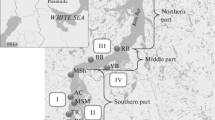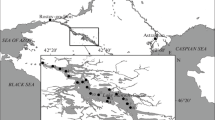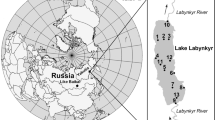Abstract
The modern soda lakes as relict biotopes, the analogs of which could be widespread in the Precambrian Era, are considered in the context of two hypotheses: “soda ocean” and “soda continent.” The diversity of modern halophilic and alkaliphilic cyanobacteria has been analyzed in order to reveal the morphological forms which have paleo-analogs that could be used as indicators of soda conditions in the Precambrian.

Similar content being viewed by others
REFERENCES
Andreote, A.P.D., Vaz, M.G.M.V., Genuário, D.B., Barbiero, L., Rezende-Filho, A.T., and Fiore, M.F., Nonheterocytous cyanobacteria from Brazilian saline-alkaline lakes, J. Phycol., 2014, vol. 50, no. 4, pp. 675–684.
Astafieva, M.M., Prokaryotes in the Early Precambrian, Paleontol. J., 2013, vol. 47, no. 9, pp. 973–976.
Astafieva, M.M., Gerasimenko, L.M., Geptner, A.L., Zhegallo, E.A., Zhmur, S.I., Karpov, G.A., Orleansky, V.K., Ponomarenko, A.G., Rozanov, A.Yu., Ushatinskaya, G.T., Hoover, R.B., and Shkolnik, E.L., Iskopaemye bakterii i drugie mikroorganizmy v zemnykh porodakh i astromaterialakh (Fossil Bacteria and Other Microorganisms in Terrestrial Rocks and Astromaterials), Rozanov, A.Yu. and Ushatinskaya, G.T., Eds., Moscow: Paleontol. Inst. Ross. Akad. Nauk, 2011.
Ballot, A., Dadheech, P.K., Haande, S., and Krienitz, L., Morphological and phylogenetic analysis of Anabaenopsis abijatae and Anabaenopsis elenkinii (Nostocales, Cyanobacteria) from tropical inland water bodies, Microb. Ecol., 2008, vol. 55, no. 4, pp. 608–618.
Bolhuis, H., Severin, I., Confurius-Guns, V., Wollenzien, U.I.A., and Stal, L.J., Horizontal transfer of the nitrogen fixation gene cluster in the cyanobacterium Microcoleus chthonoplastes, ISME J., 2010, vol. 4, no. 1, pp. 121–130.
Budinoff, C.R., Ecophysiology of a Mono Lake cyanobacterium, Master of Science thesis, 2005, p. 34. https://getd.libs.uga.edu/pdfs/budinoff_charles_r_200512_ ms.pdf.
Butterfield, N.J., Proterozoic photosynthesis—a critical review, Palaeontology, 2015, vol. 58, no. 6, pp. 953–972.
Dadheech, K.P., Ballot, A., Casper, P., Kotut, K., Novelo, E., Lemma, B., Pröschold, T., and Krienitz, L., Phylogenetic relationship and divergence among planktonic strains of Arthrospira (Oscillatoriales, Cyanobacteria) of African, Asian and American origin deduced by 16S-23S ITS and phycocyanin operon sequences, Phycologia, 2010, vol. 49, no. 4, pp. 361–372.
Dadheech, K.P., Mahmoud, H., Kotut, K., and Krienitz, L., Haloleptolyngbya alcalis gen. et sp. nov., a new filamentous cyanobacterium from the soda lake Nakuru, Kenya, Hydrobiologia, 2012, vol. 691, no. 1, pp. 269–283.
Dadheech, P.K., Casamatta, D.A., Casper, P., and Krienitz, L., Phormidium etoshii sp. nov. (Oscillatoriales, Cyanobacteria) described from the Etosha Pan, Namibia, based on morphological, molecular and ecological features, J. Czech Phycol. Soc. (Fottea), 2013a, vol. 13, no. 2, pp. 235–244.
Dadheech, K.P., Glöckner, G., Casper, P., Kotut, K., Mazzoni, C.J., Mbedi, S., and Krienitz, L., Cyanobacterial diversity in the hot spring, pelagic and benthic habitats of a tropical soda lake, FEMS Microbiol. Ecol., 2013b, vol. 85, no. 2, pp. 389–401.
Dubinin, A.V. and Gerasimenko, L.M., Dark anaerobic metabolism of halophilic cyanobacterium Microcoleus chthonoplastes, Mikrobiologiya, 1993, vol. 62, no. 4, pp. 639–645.
Dubinin, A.V., Gerasimenko, L.M., and Zavarzin, G.A., Nitrogen fixation by the cyanobacterium Microcoleus chthonoplastes from hypersaline lagoons of Lake Sivash, Mikrobiologiya, 1992, vol. 61, no. 5, pp. 852–857.
Dubinin, A.V., Gerasimenko, L.M., and Zavarzin, G.A., Ecophysiology and species diversity of cyanobacteria from Lake Magadi, Mikrobiologiya, 1995, vol. 64, no. 6, pp. 845–849.
Galat, D.L., Verdin, J.P., and Sims, L.L., Large-scale patterns of Nodularia spumigena blooms in Pyramid Lake, Nevada, determined from landsat imagery: 1972–1986, Hydrobiologia, 1990, vol. 197, no. 1, pp. 147–164.
García-Pichel, F., Nübel, U., and Muyzer, G., The phylogeny of unicellular, extremely halotolerant cyanobacteria, Arch. Microbiol., 1998, vol. 169, no. 6, pp. 469–482.
Gerasimenko, L.M., Dubinin, A.V., and Zavarzin, G.A., Alkaliphilic cyanobacteria from soda lakes of Tuva and their ecophysiology, Microbiology, 1996, vol. 65, no. 6, pp. 736–740.
Golubic, S., Sergeev, V.N., and Knoll, A.H., Mesoproterozoic archaeoellipsoides akinetes of heterocystous cyanobacteria, Lethaia, 1995, vol. 28, pp. 285–298.
Gorlenko, V.M., Buryukhaev, S.P., Matyugina, E.B., Borzenko, S.V., Namsaraev, Z.B., Bryantseva, I.A., Boldareva, E.N., Sorokin, D.Yu., and Namsaraev, B.B., Microbial communities of the stratified soda Lake Doroninskoe (Transbaikal Region), Microbiology, 2010, vol. 79, no. 3, pp. 390–401.
Grim, S.L. and Dick, G.J., Photosynthetic versatility in the genome of Geitlerinema sp. PCC 9228 (formerly Oscillatoria limnetica “Solar Lake”), a model anoxygenic photosynthetic cyanobacterium, Front. Microbiol., 2016, vol. 7, art. 1546.
Imhoff, J.F., Sahl, H.G., Soliman, G.S.H., and Trüper, H.G., The Wadi Natrun: Chemical composition and microbial mass developments in alkaline brines of eutrophic desert lakes, Geomicrobiol. J., 1979, vol. 1, no. 3, pp. 219–234.
Kempe, S. and Degens, E.T., An early soda ocean?, Chem. Geol., 1985, vol. 53, nos. 1–2, pp. 95–108.
Kempe, S. and Kazmierczak, J., Soda ocean hypothesis, Encyclopedia of Geobiology, Reitner J., and Thiel, V., Eds., Dordrecht: Springer-Verlag, 2011, pp. 829–833.
Kempe, S., Kazmierczak, J., and Degens, E.T., The soda ocean concept and its bearing on biotic and crustal evolution, Origin, Evolution and Modern Aspects of Biomineralization in Plants and Animals. Proceedings of the 5th International Symposium on Biomineralization, Arlington, Texas, May 18–23, 1986, Crick, R.E., Ed., New York: Plenum Press, 1989, pp. 29–43.
Komárek, J., Cyanoprokaryota. 3. Heterocytous genera, in Süßwasserflora von Mitteleuropa/Freshwater flora of Central Europe, Büdel, B., Gärtner, G., Krienitz, L., and Schagerl, M., Eds., Berlin: Heidelberg: Springer Spektrum, 2013.
Komárek, J. and Anagnostidis, K., Cyanoprokaryota 1. Chroococcales, in Süßwasserflora von Mitteleuropa 19/1, Ettl, H., Gärtner, G., Heynig, H., and Mollenhauer, D., Eds., Jena–Stuttgart–Lubeck–Ulm: Gustav Fischer, 1998.
Komárek, J. and Anagnostidis, K., Cyanoprokaryota. 2. Oscillatoriales, in Süßwasserflora von Mitteleuropa 19/2, Büdel, B., Krienitz, L., Gärtner, G., and Schagerl, M., Eds., Heidelberg: Elsevier/Spektrum, 2005.
Krienitz, L. and Kotut, F., Fluctuating algal food populations and the occurrence of lesser flamingos (Phoeniconaias minor) in the three Kenyan Rift Valley lakes, J. Phycol., 2010, vol. 46, no. 6, pp. 1088–1096.
Krienitz, L. and Schagerl, M., Tiny and tough: microphytes of East African soda lakes, Soda Lakes of East Africa, Schagerl, M., Ed., Springer International Publishing Switzerland, 2016, pp. 149–177.
Mikhodyuk, O.S., Gerasimenko, L.M., Akimov, V.N., Ivanovsky, R.N., and Zavarzin, G.A., Ecophysiology and polymorphism of the unicellular extremely natronophilic cyanobacterium Euhalothece sp. z-m001 from Lake Magadi, Microbiology, 2008, vol. 77, no. 6, pp. 717–725.
Samylina, O.S., Sapozhnikov, F.V., Gainanova, O.Yu., Ryabova, A.V., Nikitin, M.A., and Sorokin, D.Yu., Algo-bacterial communities of the Kulunda steppe (Altai Region, Russia) soda lakes, Microbiology, 2014, vol. 83, no. 6, pp. 849–860.
Schopf, J.W., Microfossils of the Early Archean apex chert: new evidence of the antiquity of life, Science, New Ser., 1993, vol. 260, no. 5108, pp. 640–646.
Schopf, J.W., Solution to Darwin’s dilemma: discovery of the missing Precambrian record of life, Proc. Natl. Acad. Sci. U.S.A., 2000, vol. 97, no. 13, pp. 67947–6953.
Schopf, J.W., Kudryavtsev, A.B., Agresti, D.G., Wdowiak, T.J., and Czaja, A.D., Laser-Raman imagery of Earth’s earliest fossils, Nature, 2002, vol. 416, pp. 73–76.
Schopf, J.W., Sergeev, V.N., and Kudryavtsev, A.B., A new approach to ancient microorganisms: taxonomy, paleoecology, and biostratigraphy of the Lower Cambrian Berkuta and Chulaktau microbiotas of South Kazakhstan, J. Paleontol., 2015, vol. 89, no. 5, pp. 695–729.
Sergeev, V.N., Gerasimenko, L.M., and Zavarzin, G.A., The Proterozoic history and present state of Cyanobacteria, Microbiology, 2002, vol. 71, no. 6, pp. 623–637.
Sergeev, V.N. and Schopf, J.W., Taxonomy, paleoecology, and biostratigraphy of the late Neoproterozoic Chichkan microbiota of South Kazakhstan: the marine biosphere on the eve of metazoan radiation, J. Paleontol., 2010, vol. 84, no. 3, pp. 363–401.
Sergeev, V.N., Sharma, M., and Shukla, Y., Proterozoic fossil cyanobacteria, The Palaeobotanist, 2012, vol. 61, pp. 189–358.
Sergeev, V.N., Knoll, A.H., Vorob’eva, N.G., and Sergeeva, N.D., Microfossils from the lower Mesoproterozoic Kaltasy Formation, East European Platform, Precambrian Res., 2016, vol. 278, pp. 87–107.
Sharma, M. and Sergeev, V.N., Genesis of carbonate precipitate patterns and associated microfossils in Mesoproterozoic formations of India and Russia—a comparative study, Precambrian Res., 2004, vol. 134, pp. 317–347.
Shirokova, L.S., Mavromatis, V., Bundeleva, I.A., Pokrovsky, O.S., Bénézeth, P., Gérard, E., Pearce, C.R., and Oelkers, E.H., Using Mg isotopes to trace cyanobacterially mediated magnesium carbonate precipitation in alkaline lakes, Aquat. Geochem., 2013, vol. 19, no. 1, pp. 1–24.
Sili, C., Torzillo, G., and Vonshak, A., Arthrospira (Spirulina), in Ecology of Cyanobacteria II: Their Diversity in Space and Time, Whitton, B.A., Ed., Dordrecht: Springer Science+Business Media B.V., 2012, pp. 677–705.
Sorokin, D.Y., Berben, T., Melton, E.D., Overmars, L., Vavourakis, C.D., and Muyzer, G., Microbial diversity and biogeochemical cycling in soda lakes, Extremophiles, 2014, vol. 18, no. 5, pp. 791–809.
Sorokin, D.Y., Abbas, B., Geleijnse, M., Pimenov, N.V., Sukhacheva, M.V., and van Loosdrecht, M.C.M., Methanogenesis at extremely haloalkaline conditions in the soda lakes of Kulunda Steppe (Altai, Russia), FEMS Microbiol. Ecol., 2015, vol. 91, no. 4, pp. 1–12.
de Souza Santos, K.R. and Sant’anna, C.L., Cyanobacteria from different types of lakes (“salina,” “salitrada,” and “baía”) representative of the Pantanal da Nhecolândia, MS, Brazil, Rev. Bras. Bot., 2010, vol. 33, no. 1, pp. 61–83.
Stueken, E.E., Buick, R., and Schauer, A.J., Nitrogen isotope evidence for alkaline lakes on late Archean continents, Earth Planet. Sci. Lett., 2015, vol. 411, pp. 1–10.
Vaz, M.G.M.V., Genuário, D.B., Andreote, A.P.D., Malone, C.F.S., Sant’Anna, C.L., Barbiero, L., and Fiore, M.F., Pantanalinema gen. nov. and Alkalinema gen. nov.: novel pseudanabaenacean genera (Cyanobacteria) isolated from saline-alkaline lakes, Int. J. Syst. Evol. Microbiol., 2015, vol. 65, pp. 298–308.
Westall, F., Fossil bacteria, in Enigmatic Microorganisms and Life in Extreme Environments, Seckbach, J., Ed., Cellular Origin, Life in Extreme Habitats and Astrobiology, vol. 1, Dordrecht, The Netherlands: Kluwer Academic Publ., 1999, pp. 73–88.
Westall, F., Microbial palaeontology and the origin of life: a personal approach, Boll. della Soc. Paleontol. Ital., 2016, vol. 55, no. 2, pp. 85–103.
Westall, F. and Walsh, M.M., The diversity of fossil microorganisms in Archaean-age rocks, in Journey to Diverse Microbial Worlds: Adaptation to Exotic Environments, Seckbach, J., Ed., Cellular Origin, Life in Extreme Habitats and Astrobiology, vol. 2, Dordrecht, The Netherlands: Springer-Verlag, 2000, pp. 15–27.
Woronichin, N.N., Data for the study of algological flora in the Kulunda steppe lakes, Izv. Glavn. Botan. Sada SSSR, 1929, vol. 28, nos. 1–2, pp. 12–40.
Zavarzin, G.A., Epicontinental soda water bodies as supposed relic biotopes of terrestrial biota formation, Mikrobiologiya, 1993, vol. 62, no. 5, pp. 789–800.
Zavarzin, G.A., Development of soda environments as a global process, Alkalofil’nye mikrobnye soobshchestva (Alkaliphilic Microbial Communities), Galchenko, V.F., Ed., Tr. Inst. Mikrobiol. im. S.N. Vinogradskogo, vol. 14, Moscow: Nauka, 2007a, pp. 8–57.
Zavarzin, G.A., Alkalofil’nye mikrobnye soobshchestva (Alkaliphilic Microbial Communities), Galchenko, V.F., Ed., Tr. Inst. Mikrobiol. im. S.N. Vinogradskogo, vol. 14, Moscow: Nauka, 2007b, pp. 58–87.
Zavarzin, G.A., Ombrophiles as the first terrestrial inhabitants, Rannyaya kolonizatsiya sushi (Early Colonization of the Land), Rozhnov, S.V., Ed., Ser. “Geo-biologicheskie sistemy v proshlom,” Moscow: Paleontol. Inst. Ross. Akad. Nauk, 2012, pp. 4–28.
ACKNOWLEDGMENTS
The author is sincerely grateful to Kanapatsky T.A., B.Sc. Biology (Winogradsky Institute of Microbiology, Russian Academy of Sciences), for the samples of cyanobacterial communities from the rivers of the Lake Elton region provided for making photographs and to Sergeev V.N., D.Sc. Biology (Geological Institute, Russian Academy of Sciences), for the photographs of fossil cyanobacteria.
The work was partially supported by the Program of the Presidium of the Russian Academy of Sciences “Evolution of Organic World and Planetary Processes” (Subprogram II) and by the Russian Foundation for Basic Research (projects no. 17-04-00324, no. 16-04-00758).
Author information
Authors and Affiliations
Corresponding author
Additional information
Translated by E. Makeeva
Rights and permissions
About this article
Cite this article
Samylina, O.S. Use of Morphology of Halophilic and Alkaliphilic Cyanobacteria as a Criterion for Detection of Soda Conditions in the Past. Paleontol. J. 52, 1162–1171 (2018). https://doi.org/10.1134/S003103011810012X
Received:
Published:
Issue Date:
DOI: https://doi.org/10.1134/S003103011810012X




